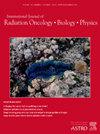Phase III Randomized Trial of Proton vs. Photon Therapy for Patients with Non-metastatic Breast Cancer Receiving Comprehensive Nodal Radiation: A Radiotherapy Comparative Effectiveness (Radcomp) Consortium Trial: Health-Related Quality of Life Outcomes
IF 6.5
1区 医学
Q1 ONCOLOGY
International Journal of Radiation Oncology Biology Physics
Pub Date : 2025-10-14
DOI:10.1016/j.ijrobp.2025.08.025
引用次数: 0
Abstract
Purpose/Objective(s)
To compare patient-reported body image and function, fatigue, and other measures of health-related quality of life (HRQOL) in a multi-institutional phase III randomized controlled trial of patients with non-metastatic breast cancer undergoing comprehensive nodal irradiation with either proton radiotherapy (PrRT) vs. photon radiotherapy (PhRT).
Materials/Methods
The primary HRQOL endpoints were PROMIS Fatigue, Satisfaction with Breast Cosmetic Outcomes, BREAST-Q adverse effects of radiotherapy, and FACT-B. Other domains, including FACIT-TS-G and PRO-CTCAE (severity, interference, frequency of chest pain and shortness of breath), were evaluated as secondary endpoints of HRQOL. HRQOL questionnaires were collected at baseline, at the end of RT, and at 1- and 6-month post-RT follow-ups. Repeated measures linear and generalized linear mixed models were used to compare the impact of treatment on continuous and ordinal/binary HRQOL scores, respectively. The study was powered for the primary endpoint of major cardiovascular events, which provided sufficient power to detect clinically meaningful differences in HRQOL, defined by an effect size of greater than 0.33, in mixed-effects models assuming a correlation of 0.40 or higher.
Results
1,239 patients were randomized to PrRT (n = 624) or PhRT (n = 615). The median age was 50 years (range, 21-92). Most patients had a mastectomy (69.7%), 0-2 cardiovascular risk factors (80.6%), and left or bilateral cancer (61.8%). FACT-B completion rate at 6 months was 86.5%. There were no clinically meaningful differences by treatment arm in the PROMIS Fatigue total score, Satisfaction with Breast Cosmetic Outcomes score, BREAST-Q total score, and FACT-B trial outcome index score. PRO-CTCAE severity of shortness of breath, when categorized as 0 vs. 1-4, favored protons (OR=0.74, 95% CI:0.59-0.93, p<0.01); but, when categorized as 0-2 vs 3-4, there was no difference between arms. Other PRO-CTCAEs assessed were similar between arms. FACIT items statistically significant in favor of protons included willingness to recommend treatment (OR=0.13, 95% CI:0.08-0.22, p<0.001) and choose treatment again (OR=0.11, 95% CI:0.07-0.18, p<0.001).
Conclusion
In the first randomized study comparing proton to photon radiation for breast cancer, HRQOL through 6 months was excellent and similar between treatment arms. Differences were noted in shortness of breath, willingness to recommend treatment, and to choose treatment again, which should be interpreted with caution in this unblinded study. Loco-regional control and major cardiac events, the primary endpoints of the RadComp trial, will be reported according to the study’s statistical plan in the future.
质子与光子治疗接受综合淋巴结放疗的非转移性乳腺癌患者的III期随机试验:放疗比较有效性(Radcomp)联合试验:与健康相关的生活质量结果
目的/目的:在一项多机构III期随机对照试验中,比较接受质子放疗(PrRT)和光子放疗(PhRT)综合淋巴结照射的非转移性乳腺癌患者报告的身体形象和功能、疲劳和其他健康相关生活质量(HRQOL)指标。材料/方法HRQOL的主要终点是PROMIS疲劳、乳房美容结果满意度、Breast - q放疗不良反应和FACT-B。其他领域,包括FACIT-TS-G和PRO-CTCAE(严重程度、干扰、胸痛频率和呼吸短促)作为HRQOL的次要终点进行评估。HRQOL问卷收集于基线、放疗结束时以及放疗后1个月和6个月随访时。使用重复测量线性和广义线性混合模型分别比较治疗对连续和有序/二元HRQOL评分的影响。该研究的主要终点是主要心血管事件,这提供了足够的能力来检测HRQOL的临床有意义的差异,在混合效应模型中,假设相关性为0.40或更高,效应大小大于0.33。结果1239例患者随机分为PrRT组(n = 624)和PhRT组(n = 615)。中位年龄为50岁(范围21-92岁)。大多数患者有乳房切除术(69.7%),0-2心血管危险因素(80.6%),左侧或双侧癌症(61.8%)。6个月时FACT-B完成率为86.5%。不同治疗组在PROMIS疲劳总分、乳房美容结果满意度评分、Breast - q总分和FACT-B试验结果指数评分方面无临床意义差异。PRO-CTCAE呼吸短促的严重程度,当分类为0比1-4时,有利于质子(OR=0.74, 95% CI:0.59-0.93, p<0.01);但是,当被分类为0-2和3-4时,手臂之间没有差异。评估的其他pro - ctcae在两组之间相似。支持质子治疗的FACIT项目有统计学意义,包括推荐治疗的意愿(OR=0.13, 95% CI:0.08-0.22, p<0.001)和再次选择治疗的意愿(OR=0.11, 95% CI:0.07-0.18, p<0.001)。结论在第一项比较质子和光子放射治疗乳腺癌的随机研究中,治疗组6个月的HRQOL非常好,且相似。在呼吸短促、推荐治疗的意愿和再次选择治疗方面存在差异,在这项非盲法研究中应谨慎解释。RadComp试验的主要终点——局部区域对照和主要心脏事件,将根据研究的统计计划在未来进行报告。
本文章由计算机程序翻译,如有差异,请以英文原文为准。
求助全文
约1分钟内获得全文
求助全文
来源期刊
CiteScore
11.00
自引率
7.10%
发文量
2538
审稿时长
6.6 weeks
期刊介绍:
International Journal of Radiation Oncology • Biology • Physics (IJROBP), known in the field as the Red Journal, publishes original laboratory and clinical investigations related to radiation oncology, radiation biology, medical physics, and both education and health policy as it relates to the field.
This journal has a particular interest in original contributions of the following types: prospective clinical trials, outcomes research, and large database interrogation. In addition, it seeks reports of high-impact innovations in single or combined modality treatment, tumor sensitization, normal tissue protection (including both precision avoidance and pharmacologic means), brachytherapy, particle irradiation, and cancer imaging. Technical advances related to dosimetry and conformal radiation treatment planning are of interest, as are basic science studies investigating tumor physiology and the molecular biology underlying cancer and normal tissue radiation response.

 求助内容:
求助内容: 应助结果提醒方式:
应助结果提醒方式:


